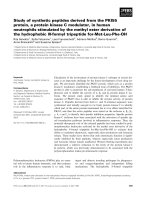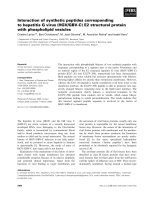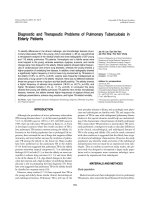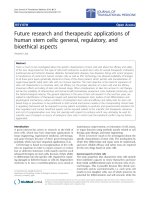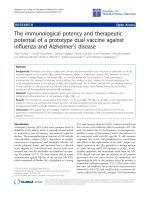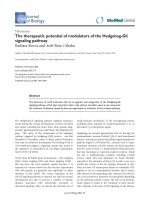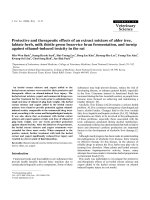Prophylactic and therapeutic potential of synthetic peptides against enterovirus 71
Bạn đang xem bản rút gọn của tài liệu. Xem và tải ngay bản đầy đủ của tài liệu tại đây (7.91 MB, 267 trang )
PROPHLACTIC AND THERAPEUTIC POTENTIAL
OF SYNTHETIC PEPTIDES AGAINST
ENTEROVIRUS 71 (EV71)
DAMIAN FOO GUANG WEI
NATIONAL UNIVERSITY OF SINGAPORE
2008
PROPHLACTIC AND THERAPEUTIC POTENTIAL
OF SYNTHETIC PEPTIDES AGAINST
ENTEROVIRUS 71 (EV71)
DAMIAN FOO GUANG WEI
B.Sc. (Hons), NUS
A THESIS SUBMITTED FOR THE DEGREE OF
DOCTOR OF PHILOSOPHY
DEPARTMENT OF MICROBIOLOGY
NATIONAL UNIVERSITY OF SINGAPORE
2008
ii
ACKNOWLEDGEMENTS
This study would not have been possible without the following people. I would like to
express my sincere thanks and utmost gratitude to:
Associate Professor Poh Chit Laa for the opportunity to pursue my postgraduate
studies under her supervision and to undertake this project. Thank you for your
invaluable guidance and support throughout the course of this study. The knowledge
and experiences gained in your laboratory were truly invaluable.
Assistant Professor Sylvie Alonso for her unwavering guidance, sound advice and
most importantly, for her friendship. Thank you for your constant encouragement,
support and the opportunity to continue my postgraduate studies under your close
supervision. I am indebted to you for providing me with the motivation to develop a
passion towards science and sharing your research experiences with me.
Associate Professor Vincent Chow Tak Kwong for his co-supervision, advice and
guidance throughout the course of this study.
Associate Professor Lu Jinhua, Assistant Professor Kevin Tan Shyong Wei and
Assistant Professor Theresa Tan May Chin for being my PhD qualifying examiners
and the opportunity for me to continue with my postgraduate studies.
Mr Ramachandran and Mrs Phoon Meng Chee for their help during the animal
study and their technical advices in tissue culture work and in vitro
microneutralization assay.
Mr Ramasamy Pallan, Mr Goh Ting Kiam, Paul, Jasmine, Li Li and Auntie
Zainal for their friendships and help in all administrative and technical matters.
Boon King, Eng Lee, Adrian, Andrew, Boon Eng, Si Ying, Wen Wei, Grace, Li
Rui, Wei Xin and Joo Lee for their help and encouragement. Thank you for all your
invaluable advices and concern. Thank you for the joy and laughter we have shared.
Chew Ling ♥ for her patience and understanding throughout my postgraduate studies.
Thank you so much for your endless encouragement, support and help especially with
the bacterial work. Also, thank you for accompanying me in lab during my late night
stints. Your love and sincerity has indeed changed me into a better person.
My parents for their unconditional love, concern and understanding in every possible
ways. Thank you for your constant support throughout my studies. You have given
me everything a child can possibly dream of. Without you, I won’t be who I am
today.
God for his eternal guidance, love and being there in my times of need. You have
given me spiritual courage and strength to face new challenges and overcome all
difficulties. Continue to guide me and strengthen my faith in you. Amen.
iii
CONTENTS
Title page i
Acknowledgements ii
Table of contents iii
List of Tables xi
List of Figures xii
Abbreviations xiv
Summary xx
CHAPTER 1 LITERATURE REVIEW
1.1 Picornaviruses 1
1.2 Genome and organization of enteroviruses 4
1.2.1 The enteroviral capsid proteins 6
1.2.2 Infection cycle 8
1.3 Enterovirus 71 (EV71) infection 10
1.3.1 Epidemiological studies 10
1.3.2 Phylogenetic studies 12
1.3.2.1 VP1-based classification 12
1.3.2.2 VP1- and VP4-based classification 13
1.3.2.3 Relationship between subgenogroups and
outbreak occurrence 14
1.3.3 Clinical features of diseases caused by enterovirus 71
(EV71) 19
1.3.3.1 Hand, foot and mouth disease (HFMD) 19
1.3.3.2 Other EV71-associated diseases 22
1.3.4 Immunopathogenesis of EV71 infection 23
iv
1.4 Diagnosis of enterovirus 71 (EV71) 23
1.4.1 Tissue culture isolation and serotyping 23
1.4.2 Immunofluorescence assay 26
1.4.3 Enzyme-Linked Immunosorbent Assay (ELISA) 27
1.4.4 Molecular detection methods 29
1.4.4.1 Reverse Transcription Polymerase Chain Reaction
(RT-PCR) 29
1.4.4.2 Combination of RT-PCR and microarray 31
1.4.4.3 PCR-ELISA 31
1.4.4.4 Real-time PCR 32
1.5 Treatment of enterovirus 71 (EV71) 36
1.5.1 Antiviral drugs 36
1.5.2 Other therapeutic approaches 37
1.5.2.1 Intravenous immunoglobulin (IVIG) 37
1.5.2.2 Interferon 38
1.6 Vaccines 38
1.6.1 Live-attenuated vaccines 40
1.6.2 Killed whole vaccines 41
1.6.3 DNA vaccines 42
1.6.4 Subunit or purified component vaccines 43
1.6.5 Synthetic peptide vaccines 44
1.7 Epitope mapping 45
1.7.1 Approaches to epitope mapping 45
1.7.2 X-ray crystallography 45
1.7.3 Viral mutants and monoclonal antibodies 45
1.7.4 Anti-peptide antibodies 47
v
1.7.5 Mapping using recombinant peptides 48
1.7.6 Mapping using synthetic peptides 48
1.8 Animal models for Enterovirus 71 (EV71) 50
1.9 Specific aims 53
CHAPTER 2 MATERIALS AND METHODS
2.1 Microbiology 55
2.1.1 Bacterial work 55
2.1.1.1 Bacterial strains and plasmids 55
2.1.1.2 Culture and storage of bacterial cells 55
2.1.1.3 Preparation of chemically competent
E. coli cells 55
2.1.1.4 Transformation of chemically competent
E. coli cells 59
2.1.2 Virus work 59
2.1.2.1 EV71 strains 59
2.1.2.2 Virus propagation 61
2.1.2.3 Purification and concentration of virus 61
2.1.2.4 50% Tissue culture infective dose (TCID
50
) assay 62
2.1.2.5 In vitro microneutralization assay 62
2.2 Cell biology 63
2.2.1 Mammalian cell line 63
2.2.1.1 Regeneration and culture of Rhabdomyosarcoma
(RD) cells 63
2.2.1.2 Storage of RD cells 63
2.2.2 T cell proliferation assay 64
2.2.2.1 Isolation of peripheral blood mononuclear cells
(PBMCs) 64
vi
2.2.2.2 In vitro culturing and activation of dendritic cells
(DCs) 64
2.2.2.3 CD4
+
T cell selection and proliferation 65
2.3 Molecular biology 66
2.3.1 Design and synthesis of EV71-specific primers and probes 66
2.3.2 Design and synthesis of conjugated and unconjugated
synthetic peptides 68
2.3.3 RNA work 68
2.3.3.1 Total RNA extraction 68
2.3.3.2 Viral genomic RNA extraction 69
2.3.3.3 Conventional RT-PCR amplification 69
2.3.3.4 Hybridization probe-based
real-time RT-PCR 70
2.3.4 DNA work 72
2.3.4.1 Isolation of plasmid DNA 72
2.3.4.1.1 Preparation of plasmids by the modified
alkaline lysis method of Birnbolm and
Doly (1979) 72
2.3.4.1.2 Preparation of plasmids by the modified
boiling method of Holmes and Quigley
(1981) 73
2.3.4.1.3 Plasmid purification using the Wizard™
SV Miniprep DNA Purification Kit
(Promega, USA) 74
2.3.4.2 Restriction endonuclease digestion of DNA 74
2.3.4.3 Agarose gel electrophoresis of DNA 75
2.3.4.4 Purification of DNA using the GFX™ Purification kit
(GE Healthcare Life Sciences, UK) 75
2.3.4.5 DNA Ligation 76
2.3.4.6 DNA automated cycle sequencing 76
vii
2.4 Biochemistry 77
2.4.1 Denaturing PAGE 77
2.4.1.1 Sodium dodecyl sulphate - polyacrylamide gel
electrophoresis (SDS-PAGE) 77
2.4.1.2 Staining of polyacrylamide gels 78
2.4.2 Western blot analysis 79
2.4.2.1 Electrophoretic transfer of proteins 79
2.4.2.2 Immunogenic development of Western blots 79
2.4.3 Expression and analysis of recombinant GST-tagged
fusion proteins 80
2.4.3.1 Growth and induction of bacteria 80
2.4.3.2 Preparation of cell extracts 80
2.4.3.3 Purification of recombinant GST-tagged
fusion proteins 81
2.4.3.3.1 MicroSpin™ GST Purification kit
(GE Healthcare Life Sciences, UK) 81
2.4.3.3.2 GSTrap™ Fast Flow column kit
(GE Healthcare Life Sciences, UK) 81
2.4.3.4 Bradford assay 82
2.4.4 Enzyme-linked Immunosorbent Assay (ELISA) 82
2.4.4.1 Detection of specific mouse or
human IgG antibodies 82
2.4.4.2 IgG-subtying 83
2.4.5 Cytokine analysis 83
2.4.6 Immunohistochemical analysis 84
2.4.7 HLA-DR typing 84
2.5 In vivo work 85
2.5.1 Immunization of mice 85
viii
2.5.2 EV71 lethal challenges 85
2.5.3 Protection studies 86
2.5.3.1 Protection afforded by maternal-transferred
antibodies 86
2.5.3.2 Passive protection afforded by mice immune sera 86
2.5.4 Harvesting of mouse organs 86
2.5.5 Human serum specimens 87
2.6 Computational analysis 87
2.6.1 Hydrophobic profile and BLAST search 87
2.6.2 T-cell epitope prediction 87
2.7 Statistical analysis 88
CHAPTER 3 IDENTIFICATION OF NEUTRALIZING LINEAR
EPITOPES FROM THE VP1 CAPSID PROTEIN OF
ENTEROVIRUS 71 USING SYNTHETIC PEPTIDES
3.1 Introduction 89
3.2 Results 91
3.2.1 Identification of EV71-neutralizing antisera from mice
immunized with synthetic peptides (preliminary study) 91
3.2.2 EV71-neutralizing antisera from mice immunized with SP55,
SP70 or heat-inactivated homologous EV71 whole virion 91
3.2.3 Immunoreactivity of antisera from mice immunized with
SP12, SP55 or SP70 97
3.2.4 Analysis of IgG responses elicited by SP55, SP70
and SP12 100
3.2.5 In silico analysis of VP1 amino acid sequences represented by
SP55 and SP70 102
3.2.6 In vitro protection afforded by antisera from mice immunized
with SP55, SP70 or heat-inactivated homologous EV71
strain 41 against heterologous EV71 strains 105
3.2.7 EV71 infection in suckling mice 108
ix
3.2.8 In vivo protection against the lethal homologous EV71
strain 41 challenge in suckling Balb/c mice born to
immunized dams 111
3.2.9 In vivo passive protection against lethal EV71 challenge
in suckling Balb/c mice 113
3.2.9.1 Homologous EV71 strain 41 challenge 113
3.2.9.2 Heterologous EV71 strains challenge 114
3.2.10 Histological examination in EV71-infected
suckling Balb/c mice 118
3.2.11 Detection of EV71 by real-time RT-PCR
hybridization probe-based assay 118
3.2.12 Cytokine profiles in suckling Balb/c mice protected
against lethal homologous EV71 strain 41 challenge 122
3.2.13 Immunogenicity of SP55 and SP70 125
3.3 Discussions 128
CHAPTER 4 IDENTIFICATION OF IMMUNODOMINANT VP1
LINEAR EPITOPE OF ENTEROVIRUS 71 USING
SYNTHETIC PEPTIDES FOR DETECTING HUMAN
ANTI-EV71 IgG ANTIBODIES IN WESTERN BLOT
4.1 Introduction 134
4.2 Results 137
4.2.1 Mapping of the immunodominant linear epitope of VP1
capsid protein 137
4.2.2 Expression of recombinant GST-VP1 and GST-SP32
fusion proteins 138
4.2.3 Detecting human anti-EV71 IgG antibodies using purified
recombinant GST-VP1 and GST-SP32 fusion proteins in
IgG-based ELISA and Western blot 140
4.2.4 Specificity of the purified recombinant GST-SP32
fusion protein as a capture antigen in Western blot 143
4.3 Discussions 145
x
CHAPTER 5 IDENTIFICATION OF HUMAN CD4
+
T-CELL
EPITOPES ON THE VP1 CAPSID PROTEIN OF
ENTEROVIRUS 71
5.1 Introduction 149
5.2 Results 150
5.2.1 Prediction of HLA-DR-restricted epitopes 150
5.2.2 HLA-DR typing and detection of anti-EV71 antibodies
in human volunteers 153
5.2.3 CD4
+
T cell proliferative responses 155
5.2.4 MHC class II-blocking experiment 158
5.2.5 Cytokine profile upon antigenic stimulation 158
5.3 Discussions 162
CHAPTER 6 CONCLUSIONS 166
6.1 Synthetic peptides as candidates to elicit
protective antibodies 167
6.2 Improvements to synthetic peptide-based
prophylactic strategy 169
6.3 Alternative diagnostic strategy 171
REFERENCES 173
APPENDICES
1 Media for Bacterial Culture A
2 Materials for Tissue Culture B
3 TCID
50
Assay D
4 Materials for SDS-PAGE F
5 Materials for Western Blot H
PUBLICATIONS
xi
LIST OF TABLES
Table 1.1 Clinical manifestations of enterovirus. A symptom may
potentially be caused by more than one enterovirus 3
Table 1.2 Summary of main HFMD outbreaks from 1997 to present 11
Table 2.1 Bacterial strains and plasmids used in this study 57
Table 2.2 Virus strains used in this study 60
Table 2.3 Nucleotide sequences of EV71-specific primers and
hybridization probes 67
Table 3.1 Immunospecificity of SP12-, SP55- and SP70-immune sera 99
Table 3.2 Total and IgG sub-type responses in SP12-, SP55- and
SP70-immune sera 101
Table 3.3 Neutralizing antibody titers elicited by SP55, SP70 and
heat-inactivated homologous EV71 whole virion in mice against
heterologous EV71 strains 107
Table 3.4 Survival rates of suckling Balb/c mice upon challenged with the
homologous or heterologous EV71 strains 117
Table 5.1 Sequences and locations of predicted promiscuous regions 152
Table 5.2 EV71 exposure of volunteers and predicted peptide binding
efficiencies 154
Table 5.3 Antigen-specific cytokine
a
secretion by stimulated CD4
+
T cells 161
xii
LIST OF FIGURES
Figure 1.1 Genome structure of EV71 5
Figure 1.2 Diagrammatic representation of the EV71 icosahedra virus capsid 7
Figure 1.3 Life cycle of Picornaviruses 9
Figure 1.4 Classification of 113 EV71 strains into genogroups based
on the VP1 gene (nucleotide position 2442 to 3332) 16
Figure 1.5 Phylogenetic tree showing classification of 25 EV71 field isolates into
subgenogroups based on alignment of the complete VP1 sequence
(nucleotide position 2442 to 3332) 17
Figure 1.6 Phylogenetic classification based on the complete VP1 region
(891 nucleotides) 18
Figure 1.7 Vesicles on the palm of a child infected with hand, foot and
mouth disease (HFMD) 21
Figure 2.1 Vector map of the pGEX-6p-1 vector 58
Figure 3.1 Infection of RD cells with a viral dose of 10
3
TCID
50
EV71 strain 41 93
Figure 3.2 In vitro microneutralization assay using a representative serum sample
from mice (n=5) immunized with the heat-inactivated homologous
EV71 whole virion 94
Figure 3.3 In vitro microneutralization assay using a representative serum sample
from mice (n=5) immunized with the synthetic peptide SP70 95
Figure 3.4 In vitro microneutralization assay using a representative serum sample
from mice (n=5) immunized with the synthetic peptide SP55 96
Figure 3.5 Western blot analysis using the synthetic peptide-antisera as
primary antibodies 98
Figure 3.6 Kyte and Doolittle hydrophobicity profiles of the VP1 capsid protein
of EV71 strain 41 103
Figure 3.7 Alignment of amino acid sequences represented by the synthetic
peptides SP55 and SP70 against heterologous EV71 strains from
different subgenogroups based on the VP1 amino acid sequences 104
Figure 3.8 Viral infection of suckling Balb/c mice with the homologous EV71
strain 41 at a lethal dose (10
3
TCID
50
per mouse) 109
xiii
Figure 3.9 Dose dependency of EV71-induced death 110
Figure 3.10 In vivo protection of suckling Balb/c mice with maternal-transferred
antibodies upon challenged with the homologous EV71 strain 41 112
Figure 3.11 In vivo passive protection of suckling Balb/c mice upon challenged
with the homologous EV71 strain 41 115
Figure 3.12 In vivo passive protection study conferred by different anti-EV71
neutralizing antibody titers 116
Figure 3.13 Detection of EV71 infection in small intestines of suckling Balb/c mice
upon challenged with the homologous EV71 strain 41 at a lethal dose
of 10
3
TCID
50
per mouse 120
Figure 3.14 Detection of EV71 by real-time RT-PCR hybridization probe assay
in suckling Balb/c mice upon challenge studies 121
Figure 3.15 Cytokine profile in suckling Balb/c mice upon EV71 challenge 123
Figure 3.16 Immunoreactivity of VP1 capsid protein against human sera
(at 1:50 dilution) by Pepscan analysis 126
Figure 3.17 Immunoreactivity of VP1 capsid protein against mice immune sera
(at 1:50 dilution) by Pepscan analysis 127
Figure 4.1 Expression of purified recombinant GST-VP1 and GST-SP32
fusion proteins 139
Figure 4.2 Western blot analysis of antigen reactivity with pooled EV71-positive
or EV71-negative sera 142
Figure 4.3 Alignment of amino acid sequences represented by the synthetic
peptide SP32 against heterologous EV71 strains from different
subgenogroups based on the VP1 amino acid sequences 144
Figure 5.1 An output of ProPred analysis of the VP1 amino acid sequence in
HTML view II for binding to 51 HLA-DR alleles 151
Figure 5.2 Proliferation of CD4
+
T cells upon stimulation with peptides or
EV71 whole virions 157
Figure 5.3 Proliferation of SP2-stimulated CD4
+
T cells in the presence of
anti-human MHC class II monoclonal antibodies 160
xiv
ABBREVIATIONS
ADCC Antibody-Dependent Cellular
Cytoxicity
AFP Acute Flaccid Paralysis
ANS Autonomic Nervous System
APC Antigen Presenting Cell
bp Base Pair
BSA Bovine Serum Albumin
ºC Degree Celsius
CA3 Coxsackievirus A3
CA5 Coxsackievirus A5
CA9 Coxsackievirus A9
CA11 Coxsackievirus A11
CA15 Coxsackievirus A15
CA16 Coxsackievirus A16
CB3 Coxsackievirus B3
CB6 Coxsackievirus B6
CD Cluster of Differentiation
cDNA Complementary
Deoxyribonucleic Acid
cm Centimeter
CNS Central Nervous System
CO
2
Carbon Dioxide
CPE Cytopathic Effect
cpm Counts Per Minute
CSF Cerebrospinal Fluid
xv
Ct Threshold Value
CTL Cytotoxic T-Lymphocyte
DC Dendritic Cell
ddH
2
O Double Distilled Water
DKP Diphtheria Toxoid
DMEM Dulbecco’s Modified Eagle’s
Medium
DMSO Dimethyl Sulphoxide
DNA Deoxyribonucleic Acid
Echo 7 Echovirus 7
E.coli Escherichia coli
EDTA Ethylenediaminetetraacetic Acid
ELISA Enzyme-linked Immunosorbent
Assay
EV68 Enterovirus 68
EV69 Enterovirus 69
EV70 Enterovirus 70
EV71 Enterovirus 71
FCS Fetal Calf Serum
FMDV Foot and Mouth Disease Virus
FITC Fluorescent Isothiocyanate
FRET Fluorescence Resonance Energy
Transfer
g Gravitational Force
GBS Guillain-Barré Syndrome
GST Glutathione S-transferase
H Hour
xvi
HCV Hepatitis C Virus
HFMD Hand, foot and mouth Disease
HLA Human Leukocyte Antigen
HRP Horse Radish Peroxidase
HTLV Human T-cell Lymphotropic
Virus
H+L Heavy and Light Chains
ICR Institute of Cancer Research
IFA Immunofluorescence Assay
IFN-γ Interferon-gamma
imDC Immature Dendritic Cell
IRES Internal Ribosome Entry Site
Ig Immunoglobulin
IL Interleukin
IPTG Isopropyl-ß-D-
thiogalactopyranosid
IPV Inactivated Polio Vaccine
IVIG Intravenous Immunoglobulin
Kan Kanamycin
kb Kilobase
kDa Kilodalton
L Liter
LB Luria-Bertani
LBM Lim Benyesh-Melnick
μg Microgram
μl Microliter
xvii
M Molar
MAR Monoclonal Antibody-resistant
MCS Multiple Cloning Site
MDCK Monkey Kidney
MEM Minimal Essential Medium
MHC Major Histocompatibility
Complex
min Minute
ml Milliliter
mm Millimeter
mM Millimolar
MoDC Monocyte-derived Dendritic Cell
mRNA Messenger Ribonucleic Acid
MRC-5 Human Lung Fibroblast
MW Molecular Weight
NBC Newborn Cotton
NBW Newborn White
nm Nanometer
nt Nucleotide
OD Optical Density
OPD O-phenylenediamine
Dihydrochloride
OPV Oral Polio Vaccine
ORF Open Reading Frame
% Percentage
P Polyprotein
xviii
PBS Phosphate-Buffered Saline
PCR Polymerase Chain Reaction
PE Polyethylene
pg Picogram
RD Rhabdomyosarcoma
RNA Ribonucleic Acid
rpm Revolution Per Min
RT-PCR Reverse Transcription
Polymerase Chain Reaction
s Second
SDS-PAGE Sodium Dodecyl Sulphate-
polyacrylamide Gel
Electrophoresis
SI Stimulation Index
SP Synthetic Peptide
TCID
50
Tissue Culture Infectious Dose
50%
TE Tris-EDTA
TEMED Tetramethylethylenediamine
Th T-helper
Tm Melting Temperature
TMB Tetramethylbenzidine
TNF-α Tumour Necrosis Factor-alpha
U Unit
UTR Untranslated Region
V Voltage
Vero African green monkey kidney
xix
VP Viral Capsid Protein
v/v Volume/volume ratio
WHO World Health Organization
w/v Weight/volume ratio
xx
SUMMARY
Enterovirus (EV71) is the agent of Hand, foot and mouth disease (HFMD), a
common and mild illness amongst infants and young children. However, in recent
years, this pathogen has posed a serious threat; large scale outbreaks of HFMD have
been reported in the Asia-Pacific region with an increasing number of cases of
neurological complications which resulted in high fatality rates.
In this study, characterization of the linear neutralizing epitopes on the VP1
capsid protein of the Enterovirus 71 strain 41 (5865/SIN/00009) (belonging to
subgenogroup B4 and isolated from a fatal case in Singapore) was undertaken.
Antisera were raised in adult Balb/c mice against 95 overlapping diphtheria toxoid-
conjugated synthetic peptides of 15 amino acids in length spanning the entire VP1
capsid protein. Two synthetic peptides, designated SP55 (VP1 amino acid residues
162 to 177) and SP70 (VP1 amino acid residues 208 to 222) were capable of eliciting
neutralizing antibodies against EV71.
Based on in vitro microneutralization assay, the synthetic peptide SP70 was
able to elicit a higher EV71-neutralizing response with a neutralizing antibody titer of
1:32 in mice when compared to the synthetic peptide SP55, eliciting an EV71-
neutralizing antibody titer of 1:8. The anti-SP70 antiserum was found to be almost as
efficient as the immune serum raised against the heat-inactivated homologous EV71
whole virion with a neutralizing antibody titer of 1:64. In addition, the total IgG
response specific to EV71 whole virion measured in the anti-SP55 or anti-SP70
antiserum was found to be as high as that measured in the immune serum raised
xxi
against the heat-inactivated homologous EV71 strain 41. Immunization of mice with
either synthetic peptide predominantly enhanced IgG1 production, suggesting that the
neutralizing antibodies elicited are likely belonging to the IgG1 subtype.
The amino acid sequences represented by SP55 and SP70 lie towards the C-
terminal part of the VP1 capsid protein of EV71 strain 41. The hydrophobicity
profiles showed that these regions are located within the major hydrophilic regions of
VP1 and hence they are expected to be exposed at the surface of the protein.
Alignment with databases showed that the amino acid residues represented by SP70
are highly conserved amongst the VP1 sequences of 25 representative EV71 strains
from different subgenogroups. In vitro microneutralization assay has shown that the
immune serum raised against SP70 was able to neutralize heterologous EV71 strains
with similar efficiencies to that obtained with the homologous EV71 strain 41,
thereby suggesting that SP70 might represent an interesting and promising peptide-
based vaccine candidate for EV71.
In addition, when passively administered to one-day-old suckling Balb/c mice
challenged with a lethal dose of 10
3
TCID
50
virus/mouse, the anti-SP70 antibodies
were able to confer 80% in vivo protection comparable to antiserum raised against the
homologous heat-inactivated EV71 whole virion. The level of protection conferred by
the anti-SP70 antiserum against heterologous EV71 strains was almost similar to that
obtained against the homologous strain, supporting that the VP1 amino acid
sequences represented by SP70 contain a highly conserved neutralizing linear epitope.
xxii
Histological examination and real-time RT-PCR hybridization probe-based
assay revealed viral infiltration in the small intestines of EV71-infected mice and the
neutralizing anti-SP70 antibodies plays a major role in the inhibition of EV71
replication in vivo which significantly reduced the viral titer. The cytokine profiles for
EV71-challenged mice showed elevated IL-6 and IFN-γ levels in unprotected mice
whereas significant lower levels were observed for mice which were protected by
passively-transferred immune sera. This observation suggests a correlation between
pro-inflammatory cytokines and the severity of EV71 infection.
The use of synthetic peptide(s) as capture antigen(s) in immunoassays
represents an interesting approach for the serodiagnostic of EV71 infection as it
would avoid the need for propagating infectious viruses. Antigenic sites on VP1
protein of EV71 strain 41 (5865/SIN/00009) were mapped by Pepscan analysis using
the 95 overlapping synthetic peptides spanning the entire VP1 amino acid sequence
against EV71-neutralizing sera from pediatric patients. A major IgG-specific
immunodominant linear epitope (VP1 amino acid residues 91 to 111), defined by the
core amino acid sequence ‘LEGTTNPNG’, was identified.
Therefore, a 15 amino acid-based synthetic peptide SP32
(DLPLEGTTNPNGYAN) which contains the core sequence of the immunodominant
VP1 linear epitope was over-expressed in Escherichia coli as a soluble recombinant
GST-SP32 fusion protein. When used as a capture antigen in Western blot, the
recombinant GST-SP32 fusion protein significantly reacted with human anti-EV71
IgG antibodies with high specificity when compared to both the recombinant GST-
VP1 fusion protein and EV71 whole virion as capture antigen. In addition,
xxiii
computational analysis also showed that the amino acid sequence represented by
SP32 was highly specific for EV71 strains with no significant homology with other
enteroviruses. Altogether, these data indicate that recombinant GST-SP32 fusion
protein which harbored the immunodominant VP1 linear epitope of EV71 could be
potentially used as a capture antigen in Western blot for detecting human anti-EV71
IgG antibodies.
The identification of human CD4
+
T-cell epitopes within a protein vaccine
candidate is of great interest as it provides a better understanding of the mechanisms
involved in protective immunity and may therefore help in the design of effective
vaccines and diagnostic tools. The entire amino acid sequence representing the VP1
capsid protein of EV71 strain 41 was submitted to analysis using a virtual matrix-
based prediction program (ProPred) for the identification of promiscuous HLA-DR
ligands. Three regions spanning amino acids 66 to 77, 145 to 159 and 247 to 261 of
VP1 were predicted to bind more than 25 different HLA-DR alleles.
The corresponding peptides (SP1 to SP3) were then tested for their abilities to
induce proliferation of CD4
+
T cells isolated from peripheral blood mononuclear cells
of five human volunteers screened positive for previous EV71 exposure and one
EV71-negative volunteer. Upon stimulation with either peptide, CD4
+
T cell
proliferative responses were observed for all EV71-positive volunteers, indicating the
presence of EV71-specific memory CD4
+
T cells. The amplitude of the proliferative
responses was peptide- and HLA-DR-dependent, and correlated well with the ProPred
predicted binding efficiencies.
xxiv
This study also showed that CD4
+
T cells from EV71-positive volunteers
produced significant levels of IL-2 and IFN-γ upon stimulation, indicative of a T cell
differentiation into Th1-type subset. Among the three peptides, SP2 induced the
highest proliferative response and cytokine production. In addition, the SP2-induced
proliferative response could be inhibited with anti-major histocompatibility complex
(MHC) class II antibody, indicating that SP2 may represent a MHC class II-restricted
CD4
+
T-cell epitope. Hence, this study demonstrates that the ProPred algorithm can
accurately predict the presence of human CD4
+
T-cell epitopes within the VP1 capsid
protein of EV71, and therefore represents a useful tool for the design of subunit
vaccines against EV71. The identification of CD4
+
T-cell epitopes also provides a
better understanding in protective immunity and may help in diagnostic tools against
EV71.


